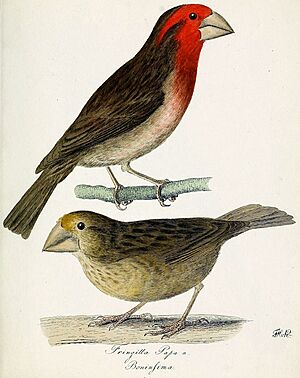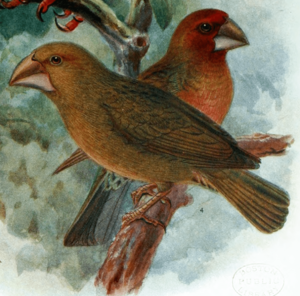Bonin grosbeak facts for kids
Quick facts for kids Bonin grosbeak |
|
|---|---|
 |
|
| Bonin grosbeaks by F.H. von Kittlitz, 1828 | |
| Conservation status | |
| Scientific classification | |
| Genus: |
Carpodacus
|
| Species: |
ferreorostris
|
The Bonin grosbeak (also called the Bonin Islands grosbeak) was a type of finch that is now extinct. This means there are no more Bonin grosbeaks left in the world. It was a unique bird, known for its large beak.
Scientists often place this bird in the genus Carpodacus. However, some think it should have its own genus, Chaunoproctus. A study in 2013 showed that the Bonin grosbeak was a very old branch on the finch family tree. It separated from other finches about 12.5 million years ago.
What Was the Bonin Grosbeak Like?
The Bonin grosbeak was a quiet bird. It was usually seen alone or in pairs. It liked to eat fruits and buds. It often found its food on the ground or on small bushes.
This bird did not fly very often. It seemed quite calm and relaxed. People only described one sound it made. It was a soft, clear, and high note. Sometimes it was short, and sometimes it was long.
Where Did the Bonin Grosbeak Live?
The Bonin grosbeak lived only on Chichi-jima island. This island is part of the Ogasawara Islands in Japan. Some old reports said it lived on other nearby islands. However, these reports were likely wrong.
Chichi-jima is the only place where people actually saw this bird. Scientists collected about 10 specimens of the Bonin grosbeak. These specimens are still around today. Old drawings of the bird show some differences, especially in the males. Scientists are not sure if these differences were because of the seasons or if there were different types of Bonin grosbeaks.
Why Did the Bonin Grosbeak Disappear?
The Bonin grosbeak was first discovered in 1827. An expedition led by Frederick William Beechey found two birds on Chichi-jima. The next year, another scientist, Kittlitz, collected more birds.
In 1830, people started to settle on Chichi-jima. This happened after two shipwrecked sailors said the island would be a good place for whalers to stop.
When another expedition visited Chichi-jima in 1854, they could not find any Bonin grosbeaks. But they did find many new animals on the island. These included rats, wild goats, sheep, dogs, and cats. Pigs were already there from 1828.
Like the Bonin thrush, the Bonin grosbeak probably died out soon after 1830. This was likely due to two main reasons:
- Habitat destruction: The new settlers changed the island.
- Predation: The new animals, like rats and cats, hunted the birds.
Some people in 1889 said the bird might still be on other islands. But this was probably not true. The Bonin grosbeak did not move around much. So, it likely only lived on Chichi-jima and nearby small islands.



